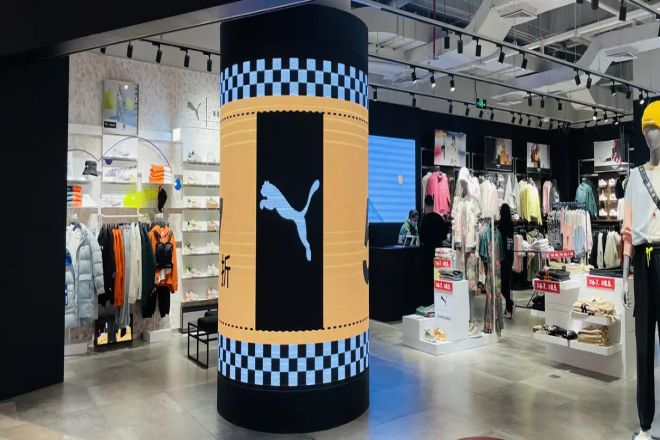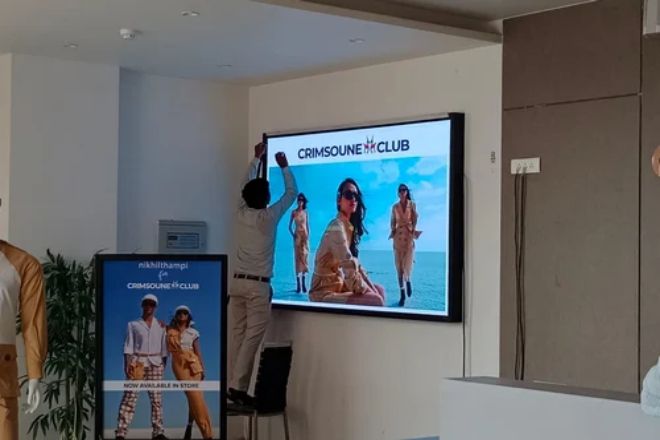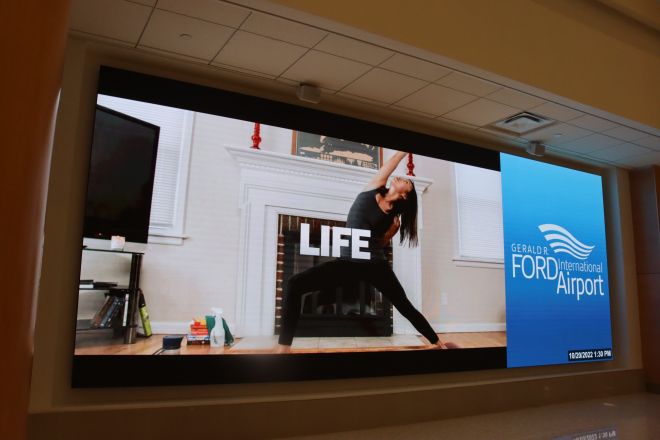Introduction

With the rapid development of technology, indoor LED displays have become an indispensable part of the modern business environment. It not only provides merchants with an efficient and flexible advertising and information dissemination platform but also greatly enriches people’s visual experience.
In this era of information explosion, the effective use of indoor LED displays to create commercial benefits has become the focus of many companies.
1. Basic features and advantages of indoor LED displays
- HD image quality and color expression
Indoor LED displays are known for their high resolution and excellent color expression, which make them capable of presenting clear, detailed, and full-color images.
This high-definition picture quality not only enhances the appeal of advertising content but also provides viewers with an excellent visual experience. Whether it is text, pictures, or videos, they can be displayed with the best effect, making the advertising information more vivid and intuitive to the audience.
- Flexibility and customizability
Indoor LED displays are extremely flexible and customizable. According to different scenarios and needs, displays of different sizes, shapes, and resolutions can be customized to adapt to various environments and applications.
In addition, the display also supports a variety of playback modes and content formats and can be customized according to the characteristics of the advertising content and the preferences of the audience. This flexibility enables indoor LED displays to meet the advertising needs of different industries and occasions.
- Energy saving and long life
Compared with traditional advertising media, indoor LED displays have lower energy consumption and longer service life. LED display screens use LED lamp beads as light-emitting components, which are highly efficient and energy-saving, and can greatly reduce operating costs.
At the same time, the lifespan of LED lamp beads is also much longer than that of traditional light bulbs, reducing the trouble and cost of frequent replacement of light bulbs. This energy-saving and long-life feature makes indoor LED displays an economical and practical advertising medium.
2. How do users profit from indoor LED displays?

Of course, getting fees by playing brand advertisements is one of the main ways to make money using indoor LED displays.
- Advertising rental fee:
Users can rent part or all of the LED display screen to brands or advertisers to display their advertising content. This rental is typically billed based on time (such as daily, weekly, or monthly) or based on impressions. The fee paid by the brand or advertiser will directly become the user’s income.
- Content customization fee:
In addition to basic advertising playback services, users can also provide content customization services. This includes creating and editing specific advertising content based on the needs of the brand or advertiser. This customized service can be charged separately or as an add-on to the advertising rental fee.
- Location premium:
If the LED display is located in a high-traffic area or a conspicuous location (such as the main passage of a shopping mall, the terminal of an airport, etc.), then its advertising value will be higher. Users can charge brands or advertisers higher fees based on this location advantage.
- Advertising performance optimization:
Users can collect and analyze audience data (such as viewing time, number of interactions, etc.) to provide advertising performance reports for brands or advertisers. Based on this data, users can provide advertising optimization suggestions to help brands or advertisers improve advertising effectiveness. This value-added service can also serve as an additional source of revenue.
- Long-term partnership:
By establishing long-term partnerships with brands or advertisers, users can gain a more stable source of income. This relationship may include exclusive advertising rights, priority leasing rights, discounts, and other preferential terms.
- Cross-screen linkage:
If the user has multiple LED displays or has partnerships with other media platforms, cross-screen linkage can be achieved. This means that brands or advertisers can display advertising content on multiple screens at the same time, increasing the coverage and impact of advertising. Cross-screen linkage may bring higher advertising costs and better advertising effects.
3. What aspects are related to the return on investment of indoor LED displays?
The return on investment (ROI) of indoor LED displays is mainly related to the following aspects:
- Advertising revenue and rental fees:
This is the main source of return on investment for LED displays. The quality and location of a display directly affects its advertising value and appeal. For example, display screens in bustling business districts or areas with dense traffic usually have higher advertising costs due to their high exposure. At the same time, high-quality displays can present more attractive advertising content, further increasing advertising revenue.
- Operating costs:
Operating costs include electricity, maintenance, updates, upgrades, etc. The energy-saving features of LED displays can reduce electricity bills, while good quality and design can reduce the frequency of maintenance and upgrades, thereby reducing operating costs. Higher operating costs reduce the return on investment.
- Investment scale:
The size of the investment directly affects the return on investment. Generally speaking, larger investments can lead to higher advertising revenue and market share but also require higher initial investments. Therefore, investors need to reasonably determine the investment scale based on their own circumstances.
- Market competition and saturation:
If the LED display market in a region is highly competitive or saturated, it may be difficult for new displays to enter the market to obtain higher advertising fees. At this time, investors need to consider ways to increase return on investment through differentiated competition and improved service quality.
- Technical updates and upgrades:
LED display technology is constantly being updated, and new technologies may bring higher display effects, lower energy consumption, and longer service life. Investors need to pay attention to technology development trends and promptly upgrade and modify the display screens to maintain their competitiveness in the market and increase return on investment.
- Regulatory and policy environment:
Different regions may have different regulations and policy environments, which will impact the return on investment of LED displays. For example, some areas may have strict restrictions or regulations on outdoor advertising, which may reduce the advertising value and return on investment of the display. Investors need to understand and comply with relevant regulations and policies.
- Operation management and maintenance level:
The level of operation management and maintenance also has an important impact on the return on investment of LED displays. Good operation management can improve the usage efficiency and advertising effect of the display; while timely and effective maintenance can extend the service life of the display and reduce the failure rate. These all help improve ROI.
4. Challenges faced and coping strategies

1). Pressure for technological upgrading
- Challenge:
With the continuous advancement of science and technology, LED display technology is also constantly being updated. New technology may bring higher display effects, lower energy consumption, and longer service life, but it also puts pressure on investors to upgrade.
- Preventive solution:
Pay close attention to industry trends and understand the latest technology development trends.
Evaluate the impact of new technologies on return on investment and formulate a reasonable technology update plan.
Establish long-term cooperative relationships with suppliers to ensure the timely introduction of new technologies and equipment.
Provide technical training to employees to improve the team’s technical level and response capabilities.
2). Fiercely competitive market environment
- Challenge:
The LED display market is highly competitive, especially in first-tier cities and bustling business districts. How to stand out among many competitors has become a major challenge for investors.
- Preventive solution:
Strengthen brand building and enhance brand awareness and reputation.
Carry out differentiated competition, provide unique advertising content and forms, and meet the personalized needs of customers.
Expand market share and expand business scope through cooperation, mergers, and acquisitions.
Improve service quality, strengthen customer relationship management, and enhance customer stickiness.
3). Audience aesthetic fatigue problem
- Challenge:
Watching similar advertising content for a long time can easily cause viewers to become fatigued, affecting advertising effectiveness and return on investment.
- Preventive solution:
Continue to innovate advertising content and forms, introduce new ideas and elements, and keep advertising fresh.
Diversified advertising display methods, such as dynamic, interactive, virtual reality, etc., improve audience participation and experience.
Accurately locate the target audience and customize advertising content according to the audience’s preferences and needs.
Change advertising content regularly to avoid repeating the same ads for a long time.
4). Legal and regulatory restrictions
- Challenge:
Different countries and regions have different legal and regulatory restrictions on the use and management of LED displays, such as advertising content, playback time, volume, etc. These restrictions may have an impact on investors’ operations.
- Preventive solution:
Understand and comply with local laws and regulations to ensure compliant operations.
Establish good communication channels with local government departments to keep abreast of policy changes and make corresponding adjustments.
Strengthen the review and supervision of advertising content to ensure that the content is legal, compliant, and ethical.
Fully consider legal and regulatory factors when formulating business strategies to reduce the risk of violations.
Conclusion
To sum up, indoor LED display screens, as an efficient and flexible advertising and information dissemination tool, have great potential and value in creating commercial benefits.
Through strategies such as precise positioning of target audiences, innovative advertising content, integrated online and offline marketing, data analysis and optimization, and cooperation and resource sharing, companies can give full play to the advantages of indoor LED displays and improve brand exposure and market competitiveness.
Finally, if you want to know more about LED displays, please get in touch with us.
